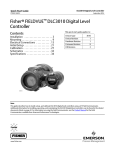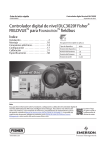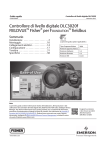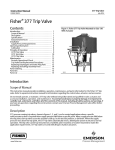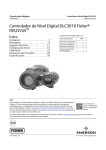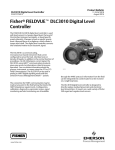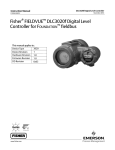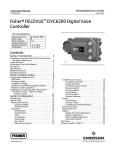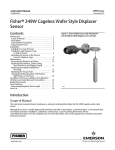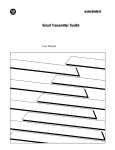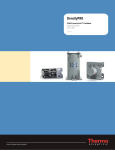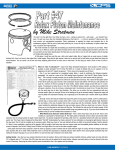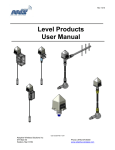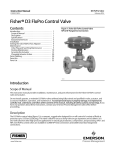Download Emerson DLC3020f Quick Start Guide
Transcript
Quick Start Guide DLC3020f Digital Level Controller D103470X012 July 2012 Fisherr FIELDVUE™ DLC3020f Digital Level Controller for FOUNDATION™ fieldbus Contents Installation . . . . . . . . . . . . . . . . . . . . . 3 Mounting . . . . . . . . . . . . . . . . . . . . . . 10 Electrical Connections . . . . . . . . . . . 14 Configuration . . . . . . . . . . . . . . . . . . 18 Calibration . . . . . . . . . . . . . . . . . . . . . 33 Nameplates and Schematics . . . . . . 37 Specifications . . . . . . . . . . . . . . . . . . 41 This quick start guide applies to: Device Type Device Revision Hardware Revision Firmware Revision DD Revision 3020 1 1.0 1.0 0x03 Note This quick start guide provides installation and initial setup and calibration information for the DLC3020f digital level controller using AMS Suite: Intelligent Device Manager. www.Fisher.com DLC3020f Digital Level Controller Quick Start Guide D103470X012 July 2012 nInstallation Check List Mounting j Instrument correctly configured and mounted on the sensor. See the appropriate mounting procedure or installation instructions provided with the mounting kit. Wiring and Electrical Connections j Conduit or I.S. barrier, if necessary, properly installed. Refer to local and national electrical codes. j Loop wiring properly connected to the LOOP + and - terminals in the terminal box. Connect loop wiring as described on page 14. 2 Quick Start Guide DLC3020f Digital Level Controller D103470X012 July 2012 Installation Do not install, operate, or maintain a DLC3020f digital level controller without being fully trained and qualified in field instrument and accessory installation, operation, and maintenance. To avoid personal injury or property damage, it is important to carefully read, understand, and follow all of the contents of this manual, including all safety cautions and warnings. If you have any questions regarding these instructions contact your Emerson Process Management sales office before proceeding. Refer to figure 1 for the installation flow chart. Figure 1. Installation Flowchart START Factory mounted on 249 sensor Yes No Install Heat Insulator Yes High temperature application? No Mount DLC3020f to Sensor Make Electrical Connections Power Device Proceed to Set Up and Calibration Configuration: On the Bench or in the Field Configure the digital level controller before or after installation in the field. It may be useful to configure the instrument on the bench before installation to ensure proper operation, and to familiarize yourself with its functionality. 3 Quick Start Guide DLC3020f Digital Level Controller D103470X012 July 2012 Protecting the Coupling and Flexures CAUTION Damage to flexures and other parts can cause measurement errors. Observe the following steps before moving the sensor and controller. Lever Lock The lever lock is built in to the coupling access door. When the door is open, it positions the lever in the neutral travel position for coupling. In some cases, this function is used to protect the lever assembly from violent motion during shipment. A DLC3020f digital level controller will have one of the following mechanical configurations when received: 1. A fully assembled and coupled caged‐displacer system shipped with the displacer or driver rod blocked within the operating range by mechanical means. In this case, the access handle (figure 2) will be in the unlocked position. Remove the displacer blocking hardware before calibration (see the appropriate sensor instruction manual). The coupling should be intact. Figure 2. Sensor Connection Compartment (Adapter Ring Removed for Clarity) MOUNTING STUDS ACCESS HOLE SHAFT CLAMP 1 SET SCREW PRESS HERE TO MOVE ACCESS HANDLE NOTE: 1 SET SCREW IS USED TO LOCK THE LEVER IN PLACE FOR OPERATION SLIDE ACCESS HANDLE TOWARD FRONT OF UNIT TO EXPOSE ACCESS HOLE CAUTION When shipping an instrument mounted on a sensor, if the lever assembly is coupled to the linkage, and the linkage is constrained by the displacer blocks, use of the lever lock may result in damage to bellows joints or flexure. 4 Quick Start Guide DLC3020f Digital Level Controller D103470X012 July 2012 2. If the displacer cannot be blocked because of cage configuration or other concerns, the transmitter is uncoupled from the torque tube by loosening the coupling nut, and the access handle will be in the locked position. Before placing such a configuration into service, couple the instrument to the sensor as follows: a. Slide the access handle to the open position to lock the lever assembly in place and expose the access hole. Press on the back of the handle as shown in figure 2 then slide the handle toward the front of the unit. Be sure the locking handle drops into the detent. b. If in process, ensure that the level or interface is in the lowest position on the displacer. c. If on the bench, ensure that the displacer is dry and the displacer rod lever arm is not hitting a travel stop. d. Insert a 10 mm deep well socket through the access hole and onto the torque tube shaft clamp nut. Tighten the clamp nut to a maximum torque of 2.1 NSm (18 lbfSin). e. Slide the access handle to the closed position. for operation or calibration. (Press on the back of the handle as shown in figure 2 then slide the handle toward the rear of the unit.) Be sure the locking handle drops into the detent. 5 Quick Start Guide DLC3020f Digital Level Controller D103470X012 July 2012 Hazardous Area Classifications and Special Instructions for “Safe Use” and Installation in Hazardous Locations Certain nameplates may carry more than one approval, and each approval may have unique installation/wiring requirements and/or conditions of “safe use”. These special instructions for “safe use” are in addition to, and may override, the standard installation procedures. Special instructions are listed by approval. WARNING Failure to follow these conditions of “safe use” could result in personal injury or property damage from fire or explosion, and area re‐classification. Note This information supplements the nameplate markings affixed to the product. Always refer to the nameplate itself to identify the appropriate certification. Contact your Emerson Process Management sales office for approval/certification information not listed here. CSA Intrinsically Safe, Explosion‐proof, Division 2, Dust Ignition‐proof No special conditions for safe use. Refer to table 1 for approval information, figure 21 for the CSA schematic, and figure 23 for a typical CSA/FM nameplate. Table 1. Hazardous Area Classifications—CSA (Canada) Certification Body Certification Obtained Entity Rating Temperature Code Enclosure Rating Fieldbus Intrinsically Safe Class I, II, III Division 1 Groups A,B,C, D,E,F,G T4 per drawing GE37118 CSA RTD Terminals Voc = 6.6 VDC Isc = 29.5 mA Po = 49 mW Ca ≤ 22 μF La ≤ 40 mH Main Circuit Terminals Vmax ≤ 24 VDC Imax ≤ 380 mA Pi ≤ 1.4 W Ci = 5 nF Li = 0 mH FISCO RTD Terminals Voc = 6.6 VDC Isc = 29.5 mA Po = 49 mW Ca ≤ 22 μF La ≤ 40 mH Main Circuit Terminals Vmax ≤ 17.5 VDC Imax ≤ 380 mA Pi ≤ 5.32 W Ci = 5 nF Li = 0 mH Explosion‐proof Class I Division 1 Groups B,C,D T6 Class I Division 2 Groups A,B,C,D T6 Dust Ignition‐proof Class II Division 1,2 Groups E,F,G T6 Class III 6 T4(Tamb ≤ 80_C) Type 4X T6(Tamb ≤ 80_C) Type 4X T6(Tamb ≤ 80_C) Type 4X --- Quick Start Guide DLC3020f Digital Level Controller D103470X012 July 2012 FM Intrinsically Safe, Explosion‐proof, Non-Incendive, Dust Ignition‐proof No special conditions for safe use. Refer to table 2 for approval information, figure 24 for the FM schematic, and figure 23 for a typical CSA/FM nameplate. Table 2. Hazardous Area Classifications—FM (United States) Certification Body Certification Obtained Entity Rating Temperature Code Enclosure Rating Fieldbus Intrinsically Safe Class I, II, III Division 1 Groups A,B,C, D,E,F,G T4 per drawing GE37117 FM RTD Terminals Voc = 6.6 VDC Isc = 29.5 mA Po = 49 mW Ca ≤ 22 μF La ≤ 40 mH Main Circuit Terminals Vmax ≤ 24 VDC Imax ≤ 380 mA Pi ≤ 1.4 W Ci = 5 nF Li = 0 mH FISCO RTD Terminals Voc = 6.6 VDC Isc = 29.5 mA Po = 49 mW Ca ≤ 22 μF La ≤ 40 mH Main Circuit Terminals Vmax ≤ 17.5 VDC Imax ≤ 380 mA Pi ≤ 5.32 W Ci = 5 nF Li = 0 mH Explosion‐proof Class I Division 1 Groups A,B,C,D T5 Non‐Incendive Class I,II,III Division 2 Groups A,B,C,D, E,F,G T4 Dust Ignition‐proof Class II Division 1 Groups E,F,G T5 −−− T4(Tamb ≤ 80_C) NEMA 4X, IP66 T5(Tamb ≤ 80_C) NEMA 4X, IP66 T4(Tamb ≤ 80_C) NEMA 4X, IP66 T5(Tamb ≤ 80_C) NEMA 4X, IP66 7 Quick Start Guide DLC3020f Digital Level Controller D103470X012 July 2012 ATEX Special Conditions for Safe Use Intrinsically Safe & Dust This apparatus can only be connected to an intrinsically safe certified equipment and this combination must be compatible regarding the intrinsic safety rules (see electrical parameters in table 3). Flameproof & Dust, Type n & Dust No special conditions for safe use. Refer to table 3 for additional approval information and figure 26 for a typical ATEX/IECEx nameplate. Table 3. Hazardous Area Classifications—ATEX Certification Certification Obtained Entity Rating Temperature Code Enclosure Rating Fieldbus II 1 G & D Intrinsically Safe Ex ia IIC T5/T6 Ga Dust Ex iaD 20 IP66 T87_C (Tamb ≤ 80_C) Da Ex iaD 20 IP66 T80_C (Tamb ≤ 73_C) Da ATEX II 2 G & D Flameproof Ex d IIC T5/T6 Dust Ex tD A21 IP66 T87_C (Tamb ≤ 80_C) Ex tD A21 IP66 T80_C (Tamb ≤ 73_C) II 3 G & D Type n Ex nA IIC T5/T6 Dust Ex tD A22 IP66 T87_C (Tamb ≤ 80_C) Ex tD A22 IP66 T80_C (Tamb ≤ 73_C) 8 Ui ≤ 24 V Ii ≤ 380 mA Pi ≤ 1.4 W Ci + 5 nF Li + 0 mH FISCO T5(Tamb ≤ 80_C) T6(Tamb ≤ 73_C) IP66 T5(Tamb ≤ 80_C) T6(Tamb ≤ 73_C) IP66 T5(Tamb ≤ 80_C) T6(Tamb ≤ 73_C) IP66 Ui ≤ 17.5 V Ii ≤ 380 mA Pi ≤ 5.32 W Ci + 5 nF Li + 0 mH --- Quick Start Guide DLC3020f Digital Level Controller D103470X012 July 2012 IECEx Conditions of Certification Intrinsically Safe & Dust This apparatus shall only be connected to an intrinsically safe certified equipment and this combination must be compatible regarding the intrinsic safety rules (see electrical parameters in table 4). Flameproof & Dust, Type n & Dust No conditions of certification. Refer to table 4 for additional approval information, and figure 26 for a typical ATEX/IECEx nameplate. Table 4. Hazardous Area Classifications—IECEx Certification Certification Obtained Entity Rating Temperature Code Enclosure Rating Fieldbus Intrinsically Safe Ex ia IIC T5/T6 Ga Dust Ex iaD 20 IP66 T87_C (Tamb ≤ 80_C) Da Ex iaD 20 IP66 T80_C (Tamb ≤ 73_C) Da IECEx Flameproof Ex d IIC T5/T6 Dust Ex tD A21 IP66 T87_C (Tamb ≤ 80_C) Ex tD A21 IP66 T80_C (Tamb ≤ 73_C) Type n Ex nA IIC T5/T6 Dust Ex tD A22 IP66 T87_C (Tamb ≤ 80_C) Ex tD A22 IP66 T80_C (Tamb ≤ 73_C) Ui ≤ 24 V Ii ≤ 380 mA Pi ≤ 1.4 W Ci + 5 nF Li + 0 mH FISCO T5(Tamb ≤ 80_C) T6(Tamb ≤ 73_C) IP66 T5(Tamb ≤ 80_C) T6(Tamb ≤ 73_C) IP66 T5(Tamb ≤ 80_C) T6(Tamb ≤ 73_C) IP66 Ui ≤ 17.5 V Ii ≤ 380 mA Pi ≤ 5.32 W Ci + 5 nF Li + 0 mH --- 9 Quick Start Guide DLC3020f Digital Level Controller D103470X012 July 2012 Mounting WARNING To avoid personal injury or property damage, always wear protective gloves, clothing, and eyewear when performing any installation operations. Personal injury or property damage due to sudden release of pressure, contact with hazardous fluid, fire, or explosion can be caused by puncturing, heating, or repairing a displacer that is retaining process pressure or fluid. This danger may not be readily apparent when disassembling the sensor or removing the displacer. Before disassembling the sensor or removing the displacer, observe the appropriate warnings provided in the sensor instruction manual. Check with your process or safety engineer for any additional measures that must be taken to protect against process media. Mounting the 249 Sensor The 249 sensor is mounted using one of two methods, depending on the specific type of sensor. If the sensor has a caged displacer, it typically mounts on the side of the vessel as shown in the left image in figure 3. If the sensor has a cageless displacer, the sensor mounts on the side or top of the vessel as shown in the right image in figure 3. Figure 3. Typical Mounting A3788‐1 A3789‐1 TYPICAL CAGED SENSOR MOUNTING 10 TYPICAL CAGELESS SENSOR MOUNTING Quick Start Guide DLC3020f Digital Level Controller D103470X012 July 2012 The DLC3020f digital level controller is typically shipped attached to the sensor. If ordered separately, it may be convenient to mount the digital level controller to the sensor and perform the initial setup and calibration before installing the sensor on the vessel. Note Caged sensors have a rod and block installed on each end of the displacer to protect the displacer in shipping. Remove these parts before installing the sensor to allow the displacer to function properly. DLC3020f Orientation Mount the DLC3020f with the torque tube shaft clamp access hole (see figure 2) pointing downward to allow accumulated moisture drainage. Note If alternate drainage is provided by the user, and a small performance loss is acceptable, the instrument could be mounted in 90 degree rotational increments around the pilot shaft axis. The LCD meter may be rotated in 90 degree increments to accommodate this. The digital level controller and torque tube arm are attached to the sensor either to the left or right of the displacer, as shown in figure 4. This can be changed in the field on the 249 sensors (refer to the appropriate sensor instruction manual). Changing the mounting also changes the effective action, because the torque tube rotation for increasing level, (looking at the protruding shaft), is clockwise when the unit is mounted to the right of the displacer and counter‐ clockwise when the unit is mounted to the left of the displacer. All 249 caged sensors have a rotatable head. That is, the digital level controller can be positioned at any of eight alternate positions around the cage as indicated by the position numbers 1 through 8 in figure 4. To rotate the head, remove the head flange bolts and nuts and position the head as desired. Mounting the DLC3020f on a 249 Sensor Refer to figure 2 unless otherwise indicated. 1. If the set screw in the access handle (figure 5) is driven against the spring plate, back it out until the head is flush with the outer surface of the handle, using a 2 mm hex key. Slide the access handle to the open position to lock the lever assembly in place and to expose the access hole. Press on the back of the handle as shown in figure 2 then slide the handle toward the front of the unit. Be sure the locking handle drops into the detent. 2. Using a 10 mm deep well socket inserted through the access hole, loosen the shaft clamp (figure 2). 3. Remove the hex nuts from the mounting studs. Do not remove the adapter ring. CAUTION Measurement errors can occur if the torque tube assembly is bent or misaligned during installation. 11 Quick Start Guide DLC3020f Digital Level Controller D103470X012 July 2012 Figure 4. Typical Mounting Positions for the FIELDVUE DLC3020f Digital Level Controller on a Fisher 249 Sensor SENSOR LEFT‐OF‐DISPLACER 1 5 7 6 RIGHT‐OF‐DISPLACER 8 1 3 CAGED 3 1 5 4 2 1 4 2 8 7 6 CAGELESS 249VS 1 249W 249W 249VS NOT AVAILABLE FOR SIZE NPS 2 CL300 AND CL600 249C SENSOR. Figure 5. Close‐up of Set‐Screw SET‐SCREW (2mm) 4. Position the digital level controller so the access hole is on the bottom of the instrument. 5. Carefully slide the mounting studs into the sensor mounting holes until the digital level controller is snug against the sensor mounting flange. 6. Reinstall the hex nuts on the mounting studs and tighten the hex nuts to 10 NSm (88.5 lbfSin). Mounting the DLC3020f for High Temperature Applications Refer to figure 7 for parts identification except where otherwise indicated. The digital level controller requires an insulator assembly when temperatures exceed the limits shown in figure 6. A torque tube shaft extension is required for a 249 sensor when using an insulator assembly. 12 Quick Start Guide DLC3020f Digital Level Controller D103470X012 July 2012 PROCESS TEMPERATURE (_F) AMBIENT TEMPERATURE (_C) -40 800 -30 -20 -10 0 10 20 30 40 50 60 80 TOO HOT HEAT INSULATOR REQUIRED 400 70 425 400 300 200 100 -325 -40 0 NO HEAT INSULATOR NECESSARY 0 1 -100 TOO COLD -20 HEAT INSULATOR REQUIRED 0 20 40 60 -200 80 100 120 140 160 176 PROCESS TEMPERATURE (_C) Figure 6. Guidelines for Use of Optional Heat Insulator Assembly AMBIENT TEMPERATURE (_F) STANDARD TRANSMITTER NOTES: 1 FOR PROCESS TEMPERATURES BELOW -29_C (-20_F) AND ABOVE 204_C (400_F) SENSOR MATERIALS MUST BE APPROPRIATE FOR THE PROCESS - SEE TABLE 9. 2. IF AMBIENT DEW POINT IS ABOVE PROCESS TEMPERATURE, ICE FORMATION MIGHT CAUSE INSTRUMENT MALFUNCTION AND REDUCE INSULATOR EFFECTIVENESS. 39A4070‐B A5494‐1 CAUTION Measurement errors can occur if the torque tube assembly is bent or misaligned during installation. 1. When mounting a DLC3020f on a 249 sensor, secure the shaft extension to the sensor torque tube shaft via the shaft coupling and set screws, with the coupling centered as shown in figure 7. 2. Slide the access handle to the locked position to expose the access hole. Press on the back of the handle as shown in figure 2 then slide the handle toward the front of the unit. Be sure the locking handle drops into the detent. Figure 7. Digital Level Controller Mounting on Sensor in High Temperature Applications INSULATOR (KEY 57) SHAFT EXTENSION (KEY 58) SET SCREWS (KEY 60) SHAFT COUPLING (KEY 59) WASHER (KEY 78) HEX NUTS (KEY 34) CAP SCREWS (KEY 63) MN28800 20A7423‐C B2707 SENSOR MOUNTING STUDS (KEY 33) DIGITAL LEVEL CONTROLLER 3. Remove the hex nuts from the mounting studs. 4. Position the insulator on the digital level controller, sliding the insulator straight over the mounting studs. 5. Install 4 washers (key 78) over the studs. Install the four hex nuts and tighten. 13 DLC3020f Digital Level Controller July 2012 Quick Start Guide D103470X012 6. Carefully slide the digital level controller with the attached insulator over the shaft coupling so that the access hole is on the bottom of the digital level controller. 7. Secure the digital level controller and insulator to the torque tube arm with four cap screws. 8. Tighten the cap screws to 10 NSm (88.5 lbfSin). Electrical Connections The following describes how to make fieldbus connections to the digital level controller. WARNING To avoid personal injury resulting from electrical shock, do not exceed the maximum input voltage specified in table 8 or on the product nameplate. If the input voltage specified differs, do not exceed the lowest specified maximum input voltage. WARNING Select wiring and/or cable glands that are rated for the environment of use (such as hazardous area, ingress protection and temperature). Failure to use properly rated wiring and/or cable glands can result in personal injury or property damage from fire or explosion Wiring connections must be in accordance with local, regional, and national codes for any given hazardous area approval. Failure to follow the local, regional, and national codes could result in personal injury or property damage from fire or explosion. Personal injury or property damage caused by fire or explosion may occur if this connection is attempted in a potentially explosive atmosphere or in an area that has been classified as hazardous. Confirm that area classification and atmosphere conditions permit the safe removal of the terminal box cover before proceeding Fieldbus Connections The digital level controller is normally powered over the bus from a fieldbus 9 to 32 volt power supply and can be connected to the segment using field wiring. Refer to the site preparation guide for proper wire types, termination, length, etc. for a fieldbus segment. Note As shipped from the factory, the DLC3020f will have the transducer block mode set Out of Service. See the Configuration section for information on setup and calibration and placing the instrument in service. The initial value for all blocks are shown in the parameter list for each block in the Blocks section. 14 Quick Start Guide DLC3020f Digital Level Controller D103470X012 July 2012 1. Remove the terminal box cover (key 6) from the terminal box (key 5). 2. Bring the field wiring into the terminal box. When applicable, install conduit using local and national electrical codes which apply to the application. 3. Connect one wire from the control system output card to the LOOP + terminal in the terminal box as shown in figure 8. Connect the other wire from the control system output card to the LOOP - terminal. The instrument is not polarity sensitive. WARNING Personal injury or property damage, caused by fire or explosion, can result from the discharge of static electricity. Connect a 14 AWG (2.08 mm2) ground strap between the digital level controller and earth ground when flammable or hazardous gases are present. Refer to national and local codes and standards for grounding requirements. 4. As shown in figure 8, ground terminals are available for connecting a safety ground, earth ground, or drain wire. The safety ground terminal is electrically identical to the earth ground. Make connections to these terminals following national and local codes and plant standards. 5. Replace and tighten the terminal box cover, ensuring that it is weather‐tight; engage the optional set screw lock if required. Figure 8. Terminal Box Assembly CLIP‐ON + CLIP‐ON - RTD SIMULATE ENABLE SAFETY GROUND LOOP+ LOOP- 15 DLC3020f Digital Level Controller July 2012 Quick Start Guide D103470X012 Communication Connections WARNING Personal injury or property damage caused by fire or explosion may occur if this connection is attempted in a potentially explosive atmosphere or in an area that has been classified as hazardous. Confirm that area classification and atmosphere conditions permit the safe removal of the terminal box cap before proceeding. Note Host system device manager interfaces, such as Emerson's AMS Device Manager or the Field Communicator communicate directly with the device. A FOUNDATION fieldbus communicating device, such as a Field Communicator, interfaces with the DLC3020f from any wiring termination point in the segment. If you choose to connect the fieldbus communicating device directly to the instrument, attach the device to the LOOP + / - clip‐on connections inside the terminal box to provide local communications with the instrument. 16 Quick Start Guide DLC3020f Digital Level Controller D103470X012 July 2012 nConfiguration and Calibration Check List j Configuration and Calibration complete. j Configuration check. Confirm all final process data is correctly entered. j j Transmitter correctly reports PV. Ensure Setup Calibration log is saved. Transmitter is ready to be placed on line. Accessing Configuration and Calibration Procedures Navigation paths for Configuration and Calibration procedures are included for both AMS Device Manager and the Field Communicator. For example, to access Guided Calibrations: AMS Device Manager Configure > Calibrate > Guided Calibrations Field Communicator Configure > Calibrate > Full Calibration (Bench) or Full Calibration (Field) Menu selections are shown in italics, e.g., Full Calibration (Field). 17 DLC3020f Digital Level Controller Quick Start Guide D103470X012 July 2012 Configuration Note This quick start guide documents procedures in AMS Device Manager 10.5 and later. Earlier versions of AMS Device Manager contain the same procedures and methods, but access is through the block in which they reside. Note The primary transducer block must be set to out of service before the device can be configured. When using AMS Device Manager 10.1 and earlier go to Target Mode in Block Modes tab to set the primary transducer block in and out of service. Refer to figure 9. Figure 9. Block Modes Tab (AMS Device Manager 10.1 and earlier) BLOCK MODES SET THE TARGET MODE TO OUT OF SERVICE CONFIGURE Guided Setup AMS Device Manager Configure > Guided Setup Field Communicator Configure > Instrument Setup Access Instrument Setup from the Guided Setup tab, as shown in figure 10, for sensor, device and process fluid setup. Follow the prompts to setup the DLC3020f. 18 Quick Start Guide DLC3020f Digital Level Controller D103470X012 July 2012 Figure 10. Guided Setup GUIDED SETUP INSTRUMENT SETUP CONFIGURE Manual Setup AMS Device Manager Configure > Manual Setup Field Communicator Configure > Manual Setup The Device, Process Fluid, Instrument Display, Snap Acting Control, and Options tabs are accessible through Manual Setup. Note An error will be generated if the instrument is put back in service without applying device configuration changes; you must apply changes before putting the instrument back In Service. To clear an error, set the Mode to Out of Service, select Apply, then put back In Service. Device Select the Device tab (figure 11) to access Variable Configuration, Sensor Limits, Sensor Hardware Information, Sensor Units, Mode, Sensor Parameters, Instrument Mount Position, and Torque Tube. Variable Configuration Type of Measurement— Level or Interface Primary Value Range High— defines the maximum operational end point for reported PV. Primary Value Range Low— defines the minimum operational end point for reported PV. Default is above zero. 19 Quick Start Guide DLC3020f Digital Level Controller D103470X012 July 2012 Figure 11. Configure > Manual Setup > Device DEVICE TAB VARIABLE CONFIGURATION SELECT UNIT SYSTEM SENSOR PARAMETERS MANUAL SETUP SENSOR LIMITS CONFIGURE SENSOR HARDWARE INFORMATION TORQUE TUBE INSTRUMENT MOUNT POSITION Primary Value Offset— the constant offset applied to the level/interface measurement. Primary Value Range Units— units for PV, PV Range, and Sensor Limits. Sensor Limits Upper Sensor Limit— Indicates the maximum usable value for the Primary Value Range High. Lower Sensor Limit— Indicates the minimum usable value for the Primary Value Range Low. The Upper and Lower Sensor Limit limit what the DLC3020f can read; values above and below these limits will not be detected by the instrument. This is a dynamic reading based on temperature used when Temperature Compensation is enabled. Sensor Hardware Information Enter the following information by selecting Sensor Hardware Information. Model Type, End Connection Style, End Connection Type, Body Material, Pressure Rating, Mechanical Sensor Serial Number, Displacer Size Displacer Material, Displacer Rating, G Dimension, Torque Tube Material, Torque Tube Wall, Heat Insulator. Sensor information is typically found on the sensor nameplate, as shown in figure 12. Note This data is informational only and is not used in calibration or PV calculations. 20 Quick Start Guide DLC3020f Digital Level Controller D103470X012 July 2012 Sensor Units Select the appropriate sensor units for your application. Note Default units from factory are SI (Metric). If you choose Mixed Units you must select the units for each sensor parameter. Figure 12. Typical Sensor Nameplate SENSOR TYPE DISPLACER PRESSURE RATING ASSEMBLY PRESSURE RATING DISPLACER WEIGHT 76543210 249B PSI 285/100 F 1500 PSI 2 x 32 INCHES WCB STL 103 CU‐IN 4 3/4 LBS MONEL 316 SST K MONEL/STD DISPLACER MATERIAL DISPLACER VOLUME 23A1725‐E sht 1 E0366 ASSEMBLY MATERIAL TRIM MATERIAL TORQUE TUBE MATERIAL DISPLACER SIZE (DIAMETER X LENGTH) Unit System—English Units, Metric/SI Units, Mixed Units Length Units—mm, cm, m, in, or ft Volume Units—mm3, ml, L, in3 Weight Units—oz, lb, g, or kg Temperature Units—_F, _R, _C, or K Torque Rate Units—NSm/deg, dyneScm/deg, lbfSin/deg Fluid Density Units—degAPI, SGU (Specific Gravity) lb/in3, lb/ft3, lb/gal, degBaum hv, degBaum lt, kg/m3, g/cm3, kg/L, g/ml, or g/L Sensor Parameters Enter the sensor parameters. Selections shown in the drop down are based on the sensor units chosen. Displacer Length Displacer Volume Displacer Weight Driver Rod Length Instrument Mount Position 21 Quick Start Guide DLC3020f Digital Level Controller D103470X012 July 2012 Note Table 5 provides the driver rod length of 249 sensors with vertical displacers. If your sensor isn't included in table 5 refer to figure 13 to determine the driver rod length. Table 5. Driver Rod Length(1) Driver Rod Sensor Type(2) mm Inch 249 203 8.01 249B 203 8.01 249BF(3) 203 8.01 249BP 203 8.01 249C 169 6.64 249CP 169 6.64 249K 267 10.5 249L 229 9.01 249N 267 10.5 249P(3) (CL125-CL600) 203 8.01 249P(3) (CL900-CL2500) 229 9.01 249V (Special)(1)(3) See serial card See serial card 249V (Std)(3) 343 13.5 249VS 343 13.5 249W 203 8.01 1. Driver rod length is the perpendicular distance between the vertical centerline of the displacer and the horizontal centerline of the torque tube. See figure 13. If you cannot determine the driver rod length, contact your Emerson Process Management sales office and provide the serial number of the sensor. 2. This table applies to sensors with vertical displacers only. For sensor types not listed, or sensors with horizontal displacers, contact your Emerson Process Management sales office for the driver rod length. For other manufacturers' sensors, see the installation instructions for that mounting. 3. 249BF, 249P, and 249V sensors are only available in Europe. 22 Quick Start Guide DLC3020f Digital Level Controller D103470X012 July 2012 Figure 13. Method of Determining Driver Rod Length from External Measurements VERTICAL CL OF DISPLACER VESSEL HORIZONTAL CL OF TORQUE TUBE DISPLACER ROD LENGTH Torque Tube Torque Tube Material—select the material of the torque tube being used. See the sensor nameplate. View Torque Tube Table—select View Torque Tube Table to see the torque tube gain over the entire temperature range and the compensated torque rate. 23 Quick Start Guide DLC3020f Digital Level Controller D103470X012 July 2012 Process Fluid Select the Process Fluid tab (figure 14) to access Process Fluid, Temperature Compensation, and Mode. Figure 14. Configure > Manual Setup > Process Fluid MANUAL SETUP CONFIGURE PROCESS FLUID TAB PROCESS FLUID CHANGE PROCESS FLUID TEMPERATURE COMPENSATION MODE VIEW DENSITY PARAMETERS Note The instrument software contains density tables for common categories of fluids. Custom tables can be built if needed. Some fluid categories have wide variations within fluid types. Select the fluid category and then the fluid type. Input the operating process temperature and the density. The DLC3020f will load the density table that best matches the fluid type at operating conditions. Process Fluid Fluid Name Density In Use Change Process Fluid —Select Change Process Fluid to begin the process to properly select the corrections for density of the fluid that occur at operational temperature. If Temperature Compensation is selected, the proper density table for use in temperature compensation is selected. If Temperature Compensation is not needed, enter the operating conditions and name the fluid. 24 Quick Start Guide DLC3020f Digital Level Controller D103470X012 July 2012 Temperature Compensation If Temperature Compensation is selected, provide the following information: Temperature Input—select None, Manual, AO Block, or RTD. Temperature compensation, when enabled, can come from a manually entered temperature, a temperature from a fieldbus transmitter (AO block) or a temperature from an RTD. Temperature for Compensation—the temperature in use for fluid density and torque tube material compensation. View Fluid Density Table Select View Fluid Density Table to see information concerning the temperature effect on process fluid density. Instrument Display Select the Instrument Display tab (figure 15) to access Display Option, Device Display Primary Value Units, Decimal Places, Display Primary Value Offset, and Scrolling Message Control. Figure 15. Configure > Manual Setup > Instrument Display MANUAL SETUP INSTRUMENT DISPLAY TAB SCROLLING MESSAGE CONTROL MODE DISPLAY OPTION DEVICE DISPLAY PRIMARY VALUE UNITS DECIMAL PLACES DISPLAY PRIMARY VALUE OFFSET CONFIGURE Display Option Select Primary Value Only, % Range, or Primary Value / % Range to be displayed on the DLC3020f LCD. Device Display Primary Value Units Select the units for the device display Primary Value. 25 Quick Start Guide DLC3020f Digital Level Controller D103470X012 July 2012 Decimal Places Enter the number of desired decimal places for the device display. Display Primary Value Offset Enter the PV Offset to apply it to the LCD readout. Scrolling Message Control Messages that can be scrolled on the LCD screen. Choose from; Primary Value Bad, Primary Value Uncertain, Failed Alert, Maintenance Alert, or Advisory Alert. Snap Acting Control Select the Snap Acting Control tab (figure 16) to access Snap Acting Control, Primary Value, Primary Value Percent, DI1 Trip Point Settings, DI2 Trip Point Settings, and Mode. Figure 16. Configure > Manual Setup > Snap Acting Control SNAP ACTING CONTROL SNAP ACTING CONTROL TAB DI1 TRIP POINT SETTINGS MODE MANUAL SETUP PRIMARY VALUE PRIMARY VALUE PERCENT DI2 TRIP POINT SETTINGS CONFIGURE Snap Acting Control The DLC3020f can act as a snap acting controller while simultaneously reporting PV. When Snap Acting Control is enabled, either one or both of the DI blocks will act as controllers and output a 0 (inactive) or 1 (active), depending on if the level has gone past (either rising or falling) a user specified level value. Snap Acting Control—enable or disable Snap Acting Control. Snap Units—select the desired snap unit in engineering units; length units or percent (%). 26 Quick Start Guide DLC3020f Digital Level Controller D103470X012 July 2012 Primary Value PV in engineering units Primary Value Percent PV in % DI1 Trip Point Settings Set Channel 1 or 2 of the DI for snap acting control. DI1 Action—indicate whether the trip point is active on rising or falling level. DI1 Trip Point—enter the point where DI1 is active. DI1 Deadband—enter the desired deadband. This is the distance away from the trip point that DI1 clears. DI1 Readback—indicates the status of the trip point. 0 indicates that DI1 Trip is inactive. 1 indicates DI1 Trip is active. DI2 Trip Point Settings DI2 Action—indicate whether the trip point is active on rising or falling level. DI2 Trip Point—enter the point where DI2 is active. DI2 Deadband—enter the desired deadband. This is the distance away from the trip point that DI2 clears. DI2 Readback—indicates the status of the trip point. 0 indicates that DI2 Trip is inactive. 1 indicates DI2 Trip is active. Options Select the Options tab (figure 17) to access Write Alarm, Block Alarm, Write Lock, Confirm Time, Communication Timeout, Function Block Available, Features Selected, Alert Key, Maximum Alerts Allowed, Maximum Alerts Possible, Resource Block, Transducer Block, and Mode. Write Alarm The Write Alarm (WRITE_ALM [40]) is used to alert when parameters are writable to the device. Write Alarm Disabled—select to disable the Write Alarm 27 Quick Start Guide DLC3020f Digital Level Controller D103470X012 July 2012 Figure 17. Configure > Manual Setup > Options WRITE ALARM MANUAL SETUP COMMUNICATION TIMEOUT CONFIRM TIME OPTIONS TAB MODE FUNCTION BLOCK AVAILABLE ALERT KEY MAXIMUM ALERTS ALLOWED MAXIMUM ALERTS POSSIBLE BOCK ALARM RESOURCE BLOCK TRANSDUCER BLOCK CONFIGURE WRITE LOCK FEATURES SELECTED Alarm State—indicates the state of the Write Alarm. Five states are possible; Undefined, Clear‐Reported, Clear-Not Reported, Active‐Reported, Active‐Not Reported. Unacknowledged—select Undefined, Acknowledged, or Unacknowledged Block Alarm The block alarm is used for all configuration, hardware, connection failure, or system problems in the block. Alarm Summary (ALARM_SUM [37]) determines if the Write Alarm and Block Alarm are disabled. Block Alarm Disabled—select to disable the Block Alarm Alarm State—indicates the state of the Block Alarm. Five states are possible; Undefined, Clear‐Reported, Clear-Not Reported, Active‐Reported, Active‐Not Reported. Unacknowledged—select Undefined, Acknowledged, or Unacknowledged Write Lock Write Lock determines if writes are permissible to other device parameters. Write Lock— When Write Lock is set to Locked, no writes are permitted to any parameters within the device except to set Write Lock to Not Locked. When locked, the device functions normally, updating inputs and outputs and executing algorithms. When Write Lock is set to Not Locked, the Write Alarm alert is active. Write Priority—Write Priority sets the priority for Write Alarm. The lowest priority is 0. The highest is 15. 28 Quick Start Guide D103470X012 DLC3020f Digital Level Controller July 2012 Confirm Time Confirm Time determines the time in 1/32 of a millisecond, the instrument waits for confirmation of receipt of a report before trying again. If Confirm Time is 0, the instrument does not try to resend the report. Enter 0 or a value between 320000 (10 seconds) and 640000 (20 seconds). Communication Timeout Rcas Time‐Out—Rcas Timeout determines how long function blocks in the DLC3020f should wait before giving up on remote computer writes to RCas parameters. When the timeout is exceeded, the block sheds to the next mode as defined by the block shed options. If RCas Timeout is set to 0, the block will not shed from RCas. Enter a positive value in the RCas Timeout Timeout field. Time duration is in 1/32 milliseconds (640000 = 20 secs). Note Typically this parameter does not need to be changed. The unit will be operational using the default values assigned by the factory. Perform this procedure only if a remote computer is sending setpoints from your “advanced” control. Default value for RCas Timeout is 20 seconds. Rout Time-Out—ROut Timeout (SHED_ROUT [27]) determine how long function blocks in the DLC3020f should wait before giving up on computer writes to ROut parameters. When the timeout is exceeded, the block sheds to the next mode as defined by the block shed options. If ROut Timeout is set to 0, the block will not shed from ROut. Enter a positive value in the ROut Timeout field. Time duration is in 1/32 milliseconds (640000 = 20 secs). Note Typically this parameter does not need to be changed. The unit will be operational using the default values assigned by the factory. Perform this procedure only if a remote computer is sending setpoints from your “advanced” control. Default value for ROut Timeout is 20 seconds. Write Lock—permits using Write Lock to prevent any external change to parameter values. Block connections and calculation results will proceed normally, but the configuration is locked. Reannunciation—permits the instrument to support Reannunciation of alarms. Function Block Available CasIn to Transducer Block 29 DLC3020f Digital Level Controller Quick Start Guide D103470X012 July 2012 Features Selected Note Typically this parameter does not need to be changed. The unit will be operational using the default values assigned by the factory. Features Selected indicates which Resource Block Options features have been selected and is used to select the desired features. Reports—Selecting reports enables alert and event reporting. Reporting of specific alerts may be suppressed. Fault State—Selecting Fault State enables the ability of the output block to react to various abnormal conditions by shedding mode. Write Lock—When selected, permits using Write Lock to prevent any external change to parameter values. Block connections and calculation results will proceed normally, but the configuration is locked. Reannunciation— When selected, the instrument will support Reannunciation of alarms. Alert Key Alert Key is a number that permits grouping alerts. This number may be used to indicate to the operator the source of the alert, such as the instrument, plant unit, etc. Enter a value between 1 and 255. Maximum Alerts Allowed The number of alert reports that the device can send without getting a confirmation up to the maximum permitted Resource Block Tag Description— The Tag Description is used to assign a unique 32 character description to each block within the digital level controller to describe the intended application of the block. Strategy— Strategy permits strategic grouping of blocks so the operator can identify where the block is located. The blocks may be grouped by plant area, plant equipment, etc. Enter a value between 0 and 65535 in the Strategy field. Transducer Block Tag Description— The Tag Description is a 32 character description used to assign a unique description to each block within the digital level controller to describe the intended application for the block. Strategy— Strategy permits strategic grouping of blocks so the operator can identify where the block is located. The blocks may be grouped by plant area, plant equipment, etc. Enter a value between 0 and 65535 in the Strategy field. Alert Setup AMS Device Manager Configure > Alert Setup Field Communicator Configure > Alert Setup The Alert Setup tab is shown in figure 18. 30 Quick Start Guide DLC3020f Digital Level Controller D103470X012 July 2012 Figure 18. Alert Setup ALERT SETUP ALERT SETUP TAB ELECTRONICS OPERATIONAL RATE LIMIT SCROLL DOWN TO VIEW: SENSOR BOARD TEMPERATURE LIMIT INPUT COMPENSATION ERROR CONFIGURE Alerts The DLC3020f provides two levels of alerts; Instrument alerts and PlantWeb alerts. Instrument Alert Conditions Instrument Alert Conditions, when enabled, detect many operational and performance issues that may be of interest. To view these alerts, the user must open the appropriate status screen on a host such as AMS Device Manager or a Field Communicator. PlantWeb Alerts Instrument alert conditions can be used to trigger PlantWeb alerts that will be reported in Failed, Maintenance or Advisory categories, as configured by the user. PlantWeb alerts, when enabled, can participate in the DeltaV alarm interface tools such as the alarm banner, alarm list and alarm summary. When a PlantWeb alert occurs, the DLC3020f sends an event notification and waits a specified period of time for an acknowledgment to be received. This occurs even if the condition that caused the alert no longer exists. If the acknowledgment is not received within the pre‐specified time‐out period, the event notification is retransmitted. This reduces the possibility of alert messages getting lost. DLC3020f alerts can be reported in the following categories. Failed— indicates a problem with the DLC3020f that affects its operation. Immediate action is required for a Failed condition. 31 DLC3020f Digital Level Controller Quick Start Guide July 2012 D103470X012 Maintenance— indicates a problem with the DLC3020f that, if ignored, could eventually lead to its failure. Maintenance conditions require prompt action. Advisory— indicates a minor problem with the DLC3020f. An advisory condition does not have an impact on the process or device. No Category— the alert has not been categorized. Suppress PlantWeb Alert— the alert is still evaluated by the DLC3020f, but, it does not report the status condition through an instrument alert. Electronics D Pending Memory Fail— when selected indicates if a pending memory error has been detected in the main board. D Static Memory Fail— when selected indicates if a memory error has been detected in the main board. Operational D PV Exceeds Sensor Range— when selected indicates if the Primary Variable (PV) has reached or exceeded the Sensor Range and is no longer correct. D PV Range Exceeds Sensor Range— when selected indicates if the Primary Variable (PV) Range has exceeded the range of the sensor's current calibration. The PV is still accurate but could move out of sensor range. D PV Exceeds Primary Range— when selected indicates if the the Primary Variable (PV) has exceeded the PV Range. D Calibration Validity— when selected indicates if a vital calibration parameter has been changed. Rate Limit D Displacer Rise Rate Exceeded— when selected indicates if the device detected a rise rate that exceeded the Rapid Rate Limit. D Displacer Fall Rate Exceeded Alert— when selected indicates if the device detected a fall rate that exceeded the Rapid Rate Limit. D Rapid Rate Limit—when selected, triggers an alarm when the configured set point has been exceeded. Rapid rate limit is user‐configured based on application. Select Clear Rate Limit Alert to clear the alert RTD Sensor D RTD Sensor—when selected indicates if the RTD readings are out of range or the RTD is incorrectly connected. D RTD Open—when selected indicates if the RTD is not connected. Sensor Board D Instrument Temperature Sensor— when selected indicates if the electronic sensor readings are out of range. D Sensor Board Processor— when selected indicates if the device cannot communicate properly or other electronic problem is effecting the processor. 32 Quick Start Guide DLC3020f Digital Level Controller D103470X012 July 2012 D Hall Sensor— when selected indicates if the Hall Sensor readings are out of range. Temperature Limit D Instrument Temperature High— when selected indicates if the device has exceeded the Instrument Temperature High Limit. D Instrument Temperature Low— when selected indicates if the device has exceeded the Instrument Temperature Low Limit. Input Compensation Error D Temperature Input Error— when selected indicates if the AO temperature status or RTD status has become “Bad" or “Uncertain" or the device is not set up correctly to receive AO temperature. D Upper Fluid Input Error— when selected indicates if the Upper Fluid AO status has become “Bad" or “Uncertain" or the device is not setup correctly to receive AO density for the Upper Fluid. D Lower Fluid Input Error— when selected indicates if the Lower Fluid AO status has become “Bad" or “Uncertain" or the device is not setup correctly to receive AO density for the Lower Fluid. D Fluid Values Crossed— when selected indicates if the process fluid density values have crossed; the Upper Fluid density is too close to (0.1 SG), or has become greater than, the Lower Fluid density. D Invalid Custom Table— when selected indicates if the custom process fluid density table or torque tube table being used for temperature compensation is invalid. D Temperature Out of Compensation Range—when selected indicates if the Compensation Temperature has exceeded the compensation limits. Calibrate Guided Calibrations AMS Device Manager Configure > Calibrate > Guided Calibrations Field Communicator Configure > Calibrate > Full Calibration (Bench) or Full Calibration (Field) Guided Calibrations (figure 19) provides access to guided calibration methods for use in the field or on the bench. Calibration in Use Name—indicates the calibration in use. Date—indicates when the calibration was performed. Calibrator—indicates who performed the calibration. Calibration Method—indicates the method of calibration. 33 Quick Start Guide DLC3020f Digital Level Controller D103470X012 July 2012 Calibrate Instrument Choose Full Calibration (Bench) or Full Calibration (Field) and follow AMS Device Manager (or the Field Communicator or other host system) prompts to calibrate the instrument. Guided Calibration recommends an appropriate calibration procedure. Figure 19. Guided Calibrations GUIDED CALIBRATIONS TAB CALIBRATE INSTRUMENT CALIBRATE CONFIGURE Expert User Calibrations AMS Device Manager Configure > Calibrate > Expert User Calibrations Field Communicator Configure > Calibrate > Expert User Calibrations Expert User Calibrations (figure 20) allows you to select the appropriate calibration based on configuration and available application data. Follow AMS Device Manager (or the Field Communicator or other host system) prompts to calibrate the instrument. A brief description of available calibrations are included starting on page 35. Calibration in Use Name—indicates the calibration in use. Date—indicates when the calibration was performed. Calibrator—indicates who performed the calibration. Calibration Method—indicates the method of calibration. 34 Quick Start Guide DLC3020f Digital Level Controller D103470X012 July 2012 Figure 20. Expert User Calibrations CALIBRATE EXPERT USER CALIBRATIONS TAB FULL CALIBRATION TRIM CURRENT CALIBRATION CONFIGURE Calibration Descriptions Full Calibration Weight (Bench only)—Weight Calibration is a bench calibration where weights are used to simulate the different forces the device sees at the minimum and maximum levels. All configuration data is needed to perform a Weight calibration. Weights are suggested based on the current density values so that the two weights closely simulate the minimum and maximum points the device should see, or based on water for certain setups. These are suggested values only; you can enter other values if desired. Note The larger the difference in the weights, the better the calibration will be, provided that the unit is not on a mechanical stop. Note Ensure that the moment arm is not resting on a travel stop during the calibration process. Also, the weights tend to oscillate when placed on arm, so allow sufficient time for this to dissipate before capturing the points. 35 DLC3020f Digital Level Controller July 2012 Quick Start Guide D103470X012 When complete, the torque rate or gain will be correct at the calibration temperature. After finalizing the installation a zero trim may be needed since a zero shift may take place when installing the device. Two Point (Bench or Field)—A Two Point Calibration fully calibrates the device by observing the level/interface at two points. The two points must be at least 5% of the displacer length apart. All instrument configuration data is needed to perform a Two Point calibration. Use this method of calibration when the length/interface can be externally observed. Min/Max (Bench or Field)—During the Min/Max Calibration torque rate gain and zero are computed by completely submerging the displacer in two different fluids (one of which may be air or vapor). All instrument configuration data is needed to perform a Min/Max calibration and must contain the correct values for displacer volume and driver rod length. Simple Zero/Span (Field only)— for applications with relatively constant density and temperature conditions. Two points (separated by at least 5% of the displacer length) are captured in this calibration. Only the displacer length is needed to perform the Simple Zero/Span procedure. This calibration does not allow the use of Temperature Compensation Note When using Simple Zero/Span the device cannot be temperature compensated for fluids or torque tube. This calibration should only be used when the temperature and the process density do not change, otherwise an untrimmable error will occur the farther away your process conditions get from the calibrated conditions. Two Point Time Delay (Field only)—the Two Point Time Delay Calibration is a two point calibration in which the two points captured can be taken some time apart. The first point is captured and stored indefinitely until the second point is captured. All instrument configuration data is needed to perform a Two Point calibration. Trim Current Calibration Zero Trim—Zero trim is an adjustment to the current calibration. This adjustment assumes that the current torque rate is correct and the PV error is due to a shift in the zero position. Gain Trim—Gain trim is an adjustment to the current calibration. This adjustment assumes that the zero point is correct and the PV error is caused by a torque rate change. Default Gain—Default Gain is an adjustment to the current calibration. This adjustment requires you to set the default gain to the known torque tube rate. 36 Quick Start Guide DLC3020f Digital Level Controller D103470X012 July 2012 Schematics and Nameplates This section includes loop schematics required for wiring of intrinsically safe installations and typical approvals nameplates. If you have any questions, contact your Emerson Process Management sales office. Figure 21. CSA Schematic (Refer to figure 22 for Notes) HAZARDOUS LOCATION NON‐HAZARDOUS LOCATION I.S. CLASS I,II,III DIVISION 1, GROUPS A,B,C,D,E,F,G N.I. CLASS I, DIVISION 2, GROUPS A,B,C,D RTD DEVICE CSA APPROVED ENTITY DEVICE NOTE 1, 3 DLC3020F RTD MAIN CIRCUIT TERMINALS TERMINALS Voc = 6.6 VDC Vmax ≤ 24 VDC Isc = 29.5 mA Imax ≤ 380 mA Po = 49 mW Pi ≤ 1.4 W Ca ≤ 22 mF Ci = 5 nF La ≤ 40 mH Li = 0 mH 1 CSA APPROVED BARRIER NOTE 7 1 1 1 REFER TO FIGURE 22 FOR NOTES NOTE 1, 3, 4, 5, 6 FOR FIELDBUS INSTALLATION HAZARDOUS LOCATION NON‐HAZARDOUS LOCATION I.S. CLASS I,II,III DIVISION 1, GROUPS A,B,C,D,E,F,G N.I. CLASS I, DIVISION 2, GROUPS A,B,C,D RTD DEVICE CSA APPROVED FISCO DEVICE NOTE 2, 3 DLC3020F RTD MAIN CIRCUIT TERMINALS TERMINALS Voc = 6.6 VDC Vmax ≤ 17.5 VDC Isc = 29.5 mA Imax ≤ 380 mA Po = 49 mW Pi ≤ 5.32 W Ca ≤ 22 mF Ci = 5 nF La ≤ 40 mH Li = 0 mH 1 CSA APPROVED FISCO BARRIER 1 NOTE 2, 3, 4, 5, 6 CSA APPROVED FISCO TERMINATOR 1 REFER TO FIGURE 22 FOR NOTES FOR FISCO INSTALLATION GE37118 37 DLC3020f Digital Level Controller July 2012 Quick Start Guide D103470X012 Figure 22. CSA Schematics (Notes) THE ENTITY CONCEPT ALLOWS INTERCONNECTION OF INTRINSICALLY SAFE APPARATUS TO ASSOCIATED APPARATUS NOT SPECIFICALLY EXAMINED IN SUCH COMBINATION. THE CRITERIA FOR INTERCONNECTION IS THAT THE VOLTAGE (Vmax or Ui), THE CURRENT (Imax or Ii), AND THE POWER (Pmax or Pi) OF THE INTRINSICALLY SAFE APPARATUS MUST BE EQUAL TO OR GREATER THAN THE VOLTAGE (Voc or Uo) AND THE CURRENT (Isc or Io), AND THE POWER (Po) DEFINED BY THE ASSOCIATED APPARATUS. IN ADDITION, THE SUM OF THE MAX UNPROTECTED CAPACITANCE (Ci) AND MAX UNPROTECTED INDUCTANCE (Li), INCLUDING THE INTERCONNECTING CABLING CAPACITANCE (Ccable) AND CABLING INDUCTANCE (Lcable), MUST BE LESS THAN THE ALLOWABLE CAPACITANCE (Ca) AND INDUCTANCE (La) DEFINED BY THE ASSOCIATED APPARATUS. IF THE ABOVE CRITERIA IS MET, THEN THE COMBINATION MAY BE CONNECTED. Vmax or Ui w Voc or Uo Imax or Ii w Isc or Io Pmax or Pi w Po Ci + Ccable ≤ Ca Li + Lcable ≤ La THE FISCO CONCEPT ALLOWS INTERCONNECTION OF INTRINSICALLY SAFE APPARATUS TO ASSOCIATED APPARATUS NOT SPECIFICALLY EXAMINED IN SUCH COMBINATION. THE CRITERIA FOR THE INTERCONNECTION IS THAT THE VOLTAGE (Vmax or Ui), CURRENT (Imax or Ii) AND POWER (Pmax or Pi), WHICH AN INTRINSICALLY SAFE APPARATUS CAN RECEIVE AND REMAIN INTRINSICALLY SAFE, CONSIDERING FAULTS, MUST BE EQUAL TO OR GREATER THAN THE VOLTAGE (Voc or Uo), CURRENT (Isc or Io), AND POWER (Po) LEVELS WHICH CAN BE DELIVERED BY THE ASSOCIATED APPARATUS, CONSIDERING FAULTS AND APPLICABLE FACTORS. IN ADDITION THE MAXIMUM UNPROTECTED CAPACITANCE (Ci) AND INDUCTANCE (Li) OF EACH APPARATUS (OTHER THAN THE TERMINATION) CONNECTED TO THE FIELDBUS MUST BE LESS THAN OR EQUAL TO 5 nF AND 10 uH RESPECTIVELY. IN EACH SEGMENT ONLY ONE ACTIVE DEVICE, NORMALLY THE ASSOCIATED APPARATUS, IS ALLOWED TO PROVIDE THE NECESSARY ENERGY FOR THE FIELDBUS SYSTEM. THE VOLTAGE (Uo or Voc or Vt) OF THE ASSOCIATED APPARATUS HAS TO BE LIMITED TO THE RANGE OF 9 V TO 17.5 VDC. ALL OTHER EQUIPMENT CONNECTED TO THE BUS CABLE HAS TO BE PASSIVE, MEANING THAT THEY ARE NOT ALLOWED TO PROVIDE ENERGY TO THE SYSTEM, EXCEPT FOR A LEAKAGE CURRENT OF 50 uA FOR EACH CONNECTED DEVICE. SEPARATELY POWERED EQUIPMENT NEEDS A GALVANIC ISOLATION TO ASSURE THAT THE INTRINSICALLY SAFE FIELDBUS CIRCUIT REMAINS PASSIVE. THE CABLE USED TO INTERCONNECT THE DEVICES NEEDS TO HAVE THE PARAMETERS IN THE FOLLOWING RANGE: LOOP RESISTANCE R': 15 TO 150 ohms/km INDUCTANCE PER UNIT LENGTH L: 0.4 TO 1 mH/km CAPACITANCE PER UNIT LENGTH C': 80 TO 200 nF/km C' = C' LINE/LINE + 0.5' LINE/SCREEN, IF BOTH LINES ARE FLOATING OR C' = C' LINE/LINE + C' LINE/SCREEN, IF THE SCREEN IS CONNECTED TO ONE LINE. LENGTH OF SPLICE: <1 m (T‐BOX MUST ONLY CONTAIN TERMINAL CONNECTIONS WITH NO ENERGY STORAGE CAPABILITY) LENGTH OF SPUR CABLE: <30 m LENGTH OF TRUNK CABLE: <1 Km AT EACH END OF THE TRUNK CABLE AN APPROVED INFALLIBLE TERMINATION WITH THE FOLLOWING PARAMETERS IS SUITABLE: R = 90 TO 100 ohms AND C = 0 TO 2.2 uF. NOTE, A BUILT‐IN TERMINATOR IS INCLUDED ON THE FIELD SIDE AND A SELECTABLE TERMINATOR IS AVAILABLE ON THE HOST SIDE. THE NUMBER OF PASSIVE DEVICES CONNECTED TO THE BUS SEGMENT IS NOT LIMITED IN THE FISCO CONCEPT FOR INTRINSICALLY SAFE REASONS. IF THE ABOVE RULES ARE RESPECTED, UP TO A TOTAL LENGTH OF 1000 m (SUM OF THE LENGTH OF THE TRUNK CABLE AND ALL SPUR CABLES), THE INDUCTANCE AND CAPACITANCE OF THE CABLE WILL NOT IMPAIR THE INTRINSIC SAFETY OF THE INSTALLATION. INSTALLATION MUST BE IN ACCORDANCE WITH THE CANADIAN ELECTRICAL CODE (CEC) PART 1 AND ANSI/ISA RP12.6 MAXIMUM SAFE AREA VOLTAGE SHOULD NOT EXCEED 250 Vrms RESISTANCE BETWEEN INTRINSICALLY SAFE GROUND AND EARTH GROUND MUST BE LESS THAN ONE OHM. LOOPS MUST BE CONNECTED ACCORDING TO THE BARRIER MANUFACTURER'S INSTRUCTIONS IF HAND‐HELD COMMUNICATOR OR MULTIPLEXER IS USED IT MUST BE CSA APPROVED WITH ENTITY PARAMETERS AND INSTALLED PER THE MANUFACTURER'S CONTROL DRAWING Figure 23. Typical CSA/FM Approvals Nameplate 38 Quick Start Guide DLC3020f Digital Level Controller D103470X012 July 2012 Figure 24. FM Schematic (Refer to figure 25 for Notes) HAZARDOUS LOCATION NON‐HAZARDOUS LOCATION I.S. CLASS I,II,III DIVISION 1, GROUPS A,B,C,D,E,F,G N.I. CLASS I, DIVISION 2, GROUPS A,B,C,D RTD DEVICE FM APPROVED ENTITY DEVICE NOTE 1, 3 DLC3020F MAIN CIRCUIT RTD TERMINALS TERMINALS Voc = 6.6 VDC Vmax ≤ 24 VDC Isc = 29.5 mA Imax ≤ 380 mA Po = 49 mW Pi ≤ 1.4 W Ca ≤ 22 mF Ci = 5 nF La ≤ 40 mH Li = 0 mH 1 FM APPROVED BARRIER NOTE 7 1 1 1 NOTE 1, 3, 4, 5, 6 FOR FIELDBUS INSTALLATION REFER TO FIGURE 25 FOR NOTES HAZARDOUS LOCATION NON‐HAZARDOUS LOCATION I.S. CLASS I,II,III DIVISION 1, GROUPS A,B,C,D,E,F,G N.I. CLASS I, DIVISION 2, GROUPS A,B,C,D RTD DEVICE FM APPROVED FISCO DEVICE NOTE 2, 3 DLC3020F RTD MAIN CIRCUIT TERMINALS TERMINALS Voc = 6.6 VDC Vmax ≤ 17.5 VDC Imax ≤ 380 mA Isc = 29.5 mA Pi ≤ 5.32 W Po = 49 mW Ci = 5 nF Ca ≤ 22 mF Li = 0 mH La ≤ 40 mH 1 FM APPROVED FISCO BARRIER 1 FM APPROVED FISCO TERMINATOR 1 NOTE 2, 3, 4, 5, 6 FOR FISCO INSTALLATION REFER TO FIGURE 25 FOR NOTES GE37117 39 DLC3020f Digital Level Controller Quick Start Guide July 2012 D103470X012 Figure 25. FM Schematics (Notes) THE ENTITY CONCEPT ALLOWS INTERCONNECTION OF INTRINSICALLY SAFE APPARATUS TO ASSOCIATED APPARATUS NOT SPECIFICALLY EXAMINED IN SUCH COMBINATION. THE CRITERIA FOR INTERCONNECTION IS THAT THE VOLTAGE (Vmax or Ui), THE CURRENT (Imax or Ii), AND THE POWER (Pmax or Pi) OF THE INTRINSICALLY SAFE APPARATUS MUST BE EQUAL TO OR GREATER THAN THE VOLTAGE (Voc or Uo) AND THE CURRENT (Isc or Io), AND THE POWER (Po) DEFINED BY THE ASSOCIATED APPARATUS. IN ADDITION, THE SUM OF THE MAX UNPROTECTED CAPACITANCE (Ci) AND MAX UNPROTECTED INDUCTANCE (Li), INCLUDING THE INTERCONNECTING CABLING CAPACITANCE (Ccable) AND CABLING INDUCTANCE (Lcable), MUST BE LESS THAN THE ALLOWABLE CAPACITANCE (Ca) AND INDUCTANCE (La) DEFINED BY THE ASSOCIATED APPARATUS. IF THE ABOVE CRITERIA IS MET, THEN THE COMBINATION MAY BE CONNECTED. Vmax or Ui w Voc or Uo Imax or Ii w Isc or Io Pmax or Pi w Po Ci + Ccable ≤ Ca Li + Lcable ≤ La THE FISCO CONCEPT ALLOWS INTERCONNECTION OF INTRINSICALLY SAFE APPARATUS TO ASSOCIATED APPARATUS NOT SPECIFICALLY EXAMINED IN SUCH COMBINATION. THE CRITERIA FOR THE INTERCONNECTION IS THAT THE VOLTAGE (Vmax or Ui), CURRENT (Imax or Ii) AND POWER (Pmax or Pi), WHICH AN INTRINSICALLY SAFE APPARATUS CAN RECEIVE AND REMAIN INTRINSICALLY SAFE, CONSIDERING FAULTS, MUST BE EQUAL TO OR GREATER THAN THE VOLTAGE (Voc or Uo), CURRENT (Isc or Io), AND POWER (Po) LEVELS WHICH CAN BE DELIVERED BY THE ASSOCIATED APPARATUS, CONSIDERING FAULTS AND APPLICABLE FACTORS. IN ADDITION THE MAXIMUM UNPROTECTED CAPACITANCE (Ci) AND INDUCTANCE (Li) OF EACH APPARATUS (OTHER THAN THE TERMINATION) CONNECTED TO THE FIELDBUS MUST BE LESS THAN OR EQUAL TO 5 nF AND 10 uH RESPECTIVELY. IN EACH SEGMENT ONLY ONE ACTIVE DEVICE, NORMALLY THE ASSOCIATED APPARATUS, IS ALLOWED TO PROVIDE THE NECESSARY ENERGY FOR THE FIELDBUS SYSTEM. THE VOLTAGE (Uo or Voc or Vt) OF THE ASSOCIATED APPARATUS HAS TO BE LIMITED TO THE RANGE OF 9 V TO 17.5 VDC. ALL OTHER EQUIPMENT CONNECTED TO THE BUS CABLE HAS TO BE PASSIVE, MEANING THAT THEY ARE NOT ALLOWED TO PROVIDE ENERGY TO THE SYSTEM, EXCEPT FOR A LEAKAGE CURRENT OF 50 uA FOR EACH CONNECTED DEVICE. SEPARATELY POWERED EQUIPMENT NEEDS A GALVANIC ISOLATION TO ASSURE THAT THE INTRINSICALLY SAFE FIELDBUS CIRCUIT REMAINS PASSIVE. THE CABLE USED TO INTERCONNECT THE DEVICES NEEDS TO HAVE THE PARAMETERS IN THE FOLLOWING RANGE: LOOP RESISTANCE R': 15 TO 150 ohms/km INDUCTANCE PER UNIT LENGTH L: 0.4 TO 1 mH/km CAPACITANCE PER UNIT LENGTH C': 80 TO 200 nF/km C' = C' LINE/LINE + 0.5' LINE/SCREEN, IF BOTH LINES ARE FLOATING OR C' = C' LINE/LINE + C' LINE/SCREEN, IF THE SCREEN IS CONNECTED TO ONE LINE. LENGTH OF SPLICE: <1 m (T‐BOX MUST ONLY CONTAIN TERMINAL CONNECTIONS WITH NO ENERGY STORAGE CAPABILITY) LENGTH OF SPUR CABLE: <30 m LENGTH OF TRUNK CABLE: <1 Km AT EACH END OF THE TRUNK CABLE AN APPROVED INFALLIBLE TERMINATION WITH THE FOLLOWING PARAMETERS IS SUITABLE: R = 90 TO 100 ohms AND C = 0 TO 2.2 uF. NOTE, A BUILT‐IN TERMINATOR IS INCLUDED ON THE FIELD SIDE AND A SELECTABLE TERMINATOR IS AVAILABLE ON THE HOST SIDE. THE NUMBER OF PASSIVE DEVICES CONNECTED TO THE BUS SEGMENT IS NOT LIMITED IN THE FISCO CONCEPT FOR INTRINSICALLY SAFE REASONS. IF THE ABOVE RULES ARE RESPECTED, UP TO A TOTAL LENGTH OF 1000 m (SUM OF THE LENGTH OF THE TRUNK CABLE AND ALL SPUR CABLES), THE INDUCTANCE AND CAPACITANCE OF THE CABLE WILL NOT IMPAIR THE INTRINSIC SAFETY OF THE INSTALLATION. INSTALLATION MUST BE IN ACCORDANCE WITH THE NATIONAL ELECTRICAL CODE (NEC) NFPA70 AND ANSI/ISA RP12.06.01 MAXIMUM SAFE AREA VOLTAGE SHOULD NOT EXCEED 250 Vrms RESISTANCE BETWEEN INTRINSICALLY SAFE GROUND AND EARTH GROUND MUST BE LESS THAN ONE OHM. LOOPS MUST BE CONNECTED ACCORDING TO THE BARRIER MANUFACTURER'S INSTRUCTIONS IF HAND‐HELD COMMUNICATOR OR MULTIPLEXER IS USED IT MUST BE FM APPROVED WITH ENTITY PARAMETERS AND INSTALLED PER THE MANUFACTURER'S CONTROL DRAWING Figure 26. Typical ATEX/IECEx Approvals Nameplate 40 Quick Start Guide DLC3020f Digital Level Controller D103470X012 July 2012 Instrument Description The FIELDVUE DLC3020f digital level controller (figure 27) is a fieldbus communicating instrument used to measure liquid level or the level of interface between two liquids using displacement sensor technology. Figure 27. FIELDVUE DLC3020f Digital Level Controller W9954-1 In addition to the normal function of reporting process level PV, the DLC3020f, using FOUNDATION fieldbus protocol, gives easy access to information critical to process operation and will readily integrate into a new or existing control system. AMS Device Manager or the 475 Field Communicator can be used to configure, calibrate, or test the digital level controller. The DLC3020f is also designed to directly replace pneumatic, analog, or HARTr transmitters/ controllers. It can be mounted on a wide variety of 249 cageless and caged level sensors as well as on other displacer type level sensors through the use of mounting adaptors. 249 Caged Sensors (see table 11) D 249, 249B, 249BF, 249C, 249K, and 249L sensors side‐mount on the vessel with the displacer mounted inside a cage outside the vessel. 249 Cageless Sensors (see table 12) D 249BP, 249CP, and 249P sensors top‐mount on the vessel with the displacer hanging down into the vessel. D 249VS sensor side‐mounts on the vessel with the displacer hanging out into the vessel. D 249W wafer‐style sensor mounts on top of a vessel or on a customer‐supplied cage. Specifications Specifications for DLC3020f are shown in table 6. Specifications for 249 sensors are shown in table 8. 41 DLC3020f Digital Level Controller Quick Start Guide July 2012 D103470X012 Related Documents Other documents containing information related to the DLC3020f digital level controllers and 249 sensors include: D Bulletin 11.2:DLC3020f - FIELDVUE DLC3020f Digital Level Controller (D103433X012) D Fisher FIELDVUE DLC3020f Digital Level Controller Instruction Manual (D103434X012) D Bulletin 34.2:249 - Fisher 249 Sensor, Level Controller, and Transmitter Dimensions (D200039X012) D Fisher 249 Caged Displacer Sensors Instruction Manual (D200099X012) D Fisher 249 Cageless Displacer Sensors Instruction Manual (D200100X012) D Fisher 249W Cageless Wafer Style Level Sensor Instruction Manual (D102803X012) D Simulation of Process Conditions for Calibration of Fisher Level Controllers and Transmitters - Supplement to 249 Sensor Instruction Manual (D103066X012) D Bolt Torque Information - Supplement to 249 Sensor Instruction Manuals (D103220X012) D Technical Monograph 7: The Dynamics of Level and Pressure Control D Technical Monograph 26: Guidelines for Selection of Liquid Level Control Equipment These documents are available from your Emerson Process Management sales office. Also visit our website at www.Fisher.com. Educational Services For information on available courses for the DLC3020f digital level controller, as well as a variety of other products, contact: Emerson Process Management Educational Services, Registration P.O. Box 190; 301 S. 1st Ave. Marshalltown, IA 50158-2823 Phone: 800-338-8158 or Phone: 641-754-3771 FAX: 641-754-3431 e‐mail: [email protected] 42 Quick Start Guide DLC3020f Digital Level Controller D103470X012 July 2012 Table 6. Specifications Block Execution Times AI, PID, DI, AO, ISEL: 15 ms ARTH: 25 ms Available Configurations Mounts on 249 caged and cageless sensors. Function: Transmitter, Controller, Switch Communications Protocol: FOUNDATION fieldbus Fieldbus Device Capabilities Backup Link Active Scheduler (BLAS) Digital Communication Protocol Performance FOUNDATION fieldbus registered device (ITK 5) Criteria Physical Layer Type(s): DLC3020f(1) 121—Low‐power signaling, bus‐powered, Entity Model I.S. Independent Linearity $0.1% of output span Accuracy $0.15% 123—Low‐power signaling, bus‐powered, non I.S. Repeatability <0.1% of full scale output Hysteresis <0.10% of output span Deadband <0.05% of input span Humidity $0.10% (RH9.2% to 90%) 511 - Low‐power signaling, bus‐powered, FISCO I.S. Note: At full design span, reference conditions. 1. To lever assembly rotation inputs. Supply Requirements 9 to 32 volts DC, 17.7 mA DC; instrument is not polarity sensitive Minimum Differential Specific Gravity 0.1 SGU with standard volume displacers Device Inputs Ambient Temperature Effect The combined temperature effect on zero and span is less than 0.01% of full scale per degree Celsius over the operating range -40 to 80_C (-40 to 176_F) Level Sensor Input (required) Rotary motion of torque tube shaft is proportional to buoyant force of the displacer caused by changes in liquid level or interface level Process Temperature Compensation Input (optional) RTD—interface for 2‐ or 3‐wire 100 ohm platinum RTD AO Block—FOUNDATION fieldbus temperature transmitter Manual—compensation values manually entered in the device Process Temperature Effect Temperature compensation can be implemented to correct for fluid density changes due to process temperature variations. See page 25 for information on how to correct with temperature compensation. Electromagnetic Compatibility Meets EN 61326-1 (First Edition) Immunity—Industrial locations per Table 2 of the EN 61326-1 standard. Performance is shown in table 7 below. Emissions—Class A ISM equipment rating: Group 1, Class A Lightning and Surge Protection—The degree of immunity to lightning is specified as Surge immunity in table 7. For additional surge protection commercially available transient protection can be used. LCD Meter Indications Process Variable in engineering units Process Variable in percent (%) only Alternating Process Variable in engineering units and percent (%) Optional: Alerts as configured Function Block Suite AI, PID, DI (two), AO (three), ISEL, and an ARTH function block -continued- 43 Quick Start Guide DLC3020f Digital Level Controller D103470X012 July 2012 Table 6. Specifications (continued) Alerts and Diagnostics Electronic Alerts advise when there is an electronic error in memory Operational Range Alerts notify when PV range and sensor range changes might affect calibration Rate Limit Alerts indicate rapid rise or fall in displacer, which can signify abnormal operating conditions RTD Alerts show health and condition of connected RTD Sensor Board Alerts indicate if the device is operating above or below maximum recommended limits; advises if the electronic sensor electronics cannot communicate properly Input Compensation Error Alerts advise of “Bad” or “Uncertain” status of AO connection or setup Simulate Function Simulate Active, when enabled, simulates an active alert without making it visible. Operating Limits Refer to Hazardous Area Classifications and Special Instructions for “Safe Use” and Installation in Hazardous Locations on page 6, and figures 21, 22, 23, 24, 25, and 26, for additional information Electrical Housing: CSA— Type 4X FM— NEMA 4X, IP66 ATEX— IP66 IECEx— IP66 Mounting Positions Digital level controllers can be mounted right‐ or left‐of‐displacer, as shown in figure 4 Construction Materials Case and Cover: Low‐copper aluminum alloy Internal: Plated steel, aluminum, and stainless steel; encapsulated printed wiring boards; Neodymium Iron Boron Magnets Electrical Connections Process Temperature: See table 9 and figure 6 Ambient Temperature(1) and Humidity Conditions Normal Limits Transport and Storage Limits Ambient Temperature -40 to 80_C (-40 to 176_F) -40 to 85_C (-40 to 185_F) Ambient Relative Humidity 0 to 95% (non‐condensing) Nominal Reference 25_C (77_F) 40% Electrical Classification Hazardous Area: CSA— Intrinsically Safe, Explosion‐proof, Division 2, Dust Ignition‐proof FM— Intrinsically Safe, Explosion‐proof, Non‐Incendive, Dust Ignition‐proof ATEX— Intrinsically Safe & Dust, Flameproof & Dust, Type n & Dust IECEx— Intrinsically Safe & Dust, Flameproof & Dust, Type n & Dust Two 1/2‐14 NPT internal conduit connections; one on bottom and one on back of terminal box. M20 adapters available Weight Less than 2.7 Kg (6 lbs) Options J Heat insulator J Mountings for Masoneilant, Yamatake, and Foxborot‐Eckhardt displacers available Declaration of SEP Fisher Controls International LLC declares this product to be in compliance with Article 3 paragraph 3 of the Pressure Equipment Directive (PED) 97 / 23 / EC. It was designed and manufactured in accordance with Sound Engineering Practice (SEP) and cannot bear the CE marking related to PED compliance. However, the product may bear the CE marking to indicate compliance with other applicable European Community Directives. 1. The pressure/temperature limits in this document and any applicable standard or code limitation should not be exceeded. 44 Quick Start Guide DLC3020f Digital Level Controller D103470X012 July 2012 Table 7. FIELDVUE DLC3020f EMC Summary Results—Immunity Port Enclosure I/O signal/control Test Level Performance Criteria(1) Phenomenon Basic Standard Electrostatic discharge (ESD) IEC 61000‐4‐2 4 kV contact 8 kV air A Radiated EM field IEC 61000‐4‐3 80 to 1000 MHz @ 10V/m with 1 kHz AM at 80% 1400 to 2000 MHz @ 3V/m with 1 kHz AM at 80% 2000 to 2700 MHz @ 1V/m with 1 kHz AM at 80% A Rated power frequency magnetic field IEC 61000‐4‐8 60 A/m at 50 Hz A Burst IEC 61000‐4‐4 1 kV A Surge IEC 61000‐4‐5 1 kV (line to ground only, each) B Conducted RF IEC 61000‐4‐6 150 kHz to 80 MHz at 3 Vrms A 1. Performance criteria: +/- 1% effect. A = No degradation during testing. B = Temporary degradation during testing, but is self‐recovering. Table 8. Fisher 249 Sensor Specifications Input Signal Liquid Level or Liquid‐to‐Liquid Interface Level:From 0 to 100 percent of displacer length Liquid Density: From 0 to 100 percent of displacement force change obtained with given displacer volume—standard volumes are J980 cm3 (60 inches3) for 249C and 249CP sensors or J1640 cm3 (100 inches3) for most other sensors; other volumes available depending upon sensor construction equalizing connection styles are numbered as shown in figure 28. Mounting Positions Most level sensors with cage displacers have a rotatable head. The head may be rotated through 360 degrees to any of eight different positions, shown in figure 4. Construction Materials See tables 10, 11, and 12 Sensor Displacer Lengths See tables 11 and 12 footnotes Operative Ambient Temperature Sensor Working Pressures Consistent with applicable ANSI pressure/temperature ratings for the specific sensor constructions shown in tables 11 and 12 Caged Sensor Connection Styles Cages can be furnished in a variety of end connection styles to facilitate mounting on vessels; the See table 9. For ambient temperature ranges, guidelines, and use of optional heat insulator, see figure 6. Options JHeat insulator, see description under Ordering Information JGauge glass for pressures to 29 bar at 232_C (420 psig at 450_F), and JReflex gauges for high temperature and pressure applications Table 9. Allowable Process Temperatures for Common Fisher 249 Sensor Pressure Boundary Materials Process Temperature Minimum Material Maximum Cast Iron -29_C (-20_F) 232_C (450_F) Steel -29_C (-20_F) 427_C (800_F) Stainless Steel -198_C (-325_F) 427_C (800_F) N04400 -198_C (-325_F) 427_C (800_F) Graphite Laminate/SST Gaskets -198_C (-325_F) 427_C (800_F) N04400/PTFE Gaskets -73_C (-100_F) 204_C (400_F) 45 Quick Start Guide DLC3020f Digital Level Controller D103470X012 July 2012 Table 10. Displacer and Torque Tube Materials Part Standard Material Other Materials Displacer 304 Stainless Steel 316 Stainless Steel, N10276, N04400, Plastic, and Special Alloys Displacer Stem, Driver Bearing, Displacer Rod and Driver 316 Stainless Steel N10276, N04400, other Austenitic Stainless Steels, and Special Alloys N05500(1) Torque Tube 316 Stainless Steel, N06600, N10276 1. N05500 is not recommended for spring applications above 232_C (450_F). Contact your Emerson Process Management sales office or application engineer if temperatures exceeding this limit are required. Table 11. Caged Displacer Sensors(1) Torqure Tube Orientation Sensor 249(3) 249B, 249BF(4) Torque tube arm rotatable with respect to equalizing connections 249C(3) 249K Standard Cage, Head, and Torque Tube Arm Material Cast iron Steel 316 stainless steel Steel Pressure Rating(2) Screwed 1‐1/2 or 2 Flanged 2 Screwed or optional socket weld 1‐1/2 or 2 CL600 Raised face or optional ring‐type joint flanged 1‐1/2 CL150, CL300, or CL600 2 CL150, CL300, or CL600 Screwed 1‐1/2 or 2 CL600 1‐1/2 CL150, CL300, or CL600 2 CL150, CL300, or CL600 Raised face or optional ring‐type joint flanged 1‐1/2 or 2 CL900 or CL1500 Ring‐type joint flanged 2(5) CL2500 Raised face flanged Steel 249L Equalizing Connection Style Size (NPS) CL125 or CL250 1. Standard displacer lengths for all styles (except 249) are 14, 32, 48, 60, 72, 84, 96, 108 and 120 inches. The 249 uses a displacer with a length of either 14 or 32 inches. 2. EN flange connections available in EMA (Europe, Middle East and Africa). 3. Not available in EMA. 4. 249BF available in Europe only. Also available in EN size DN 40 with PN 10 to PN 100 flanges and size DN 50 with PN 10 to PN 63 flanges. 5. Top connection is NPS 1 ring‐type joint flanged for connection styles F1 and F2. Figure 28. Style Number of Equalizing Connections STYLE 3 STYLE 1 STYLE 2 TOP AND BOTTOM CONNECTIONS, SCREWED (S‐1) OR FLANGED (F‐1) STYLE 4 UPPER AND LOWER SIDE CONNECTIONS, SCREWED (S‐3) OR FLANGED (F‐3) TOP AND LOWER SIDE CONNECTIONS, SCREWED (S‐2) OR FLANGED (F‐2) 28B5536‐1 B1820‐2 46 UPPER SIDE AND BOTTOM CONNECTIONS, SCREWED (S‐4) OR FLANGED (F‐4) Quick Start Guide DLC3020f Digital Level Controller D103470X012 July 2012 Table 12. Cageless Displacer Sensors(1) Mounting Mounts on top of vessel Sensor Standard Head(2), Wafer Body(6) and Torque Tube Arm Material CL150, CL300, or CL600 NPS 6 or 8 raised face CL150 or CL300 NPS 3 raised face CL150, CL300, or CL600 NPS 4 raised face or optional ring‐type joint CL900 or 1CL500 (EN PN 10 to DIN PN 250) NPS 6 or 8 raised face CL150, CL300, CL600, CL900, CL1500, or CL2500 For NPS 4 raised face or flat face CL125, 150, 250, 300, 600, 900, or 1500 (EN PN 10 to DIN PN 160) For NPS 4 butt weld end, XXS CL2500 WCC (steel) or CF8M For NPS 3 raised face CL150, CL300, or CL600 LCC (steel) or CF8M For NPS 4 raised face CL150, CL300, or CL600 Steel 249CP 316 Stainless Steel Mounts on side of vessel 249VS Mounts on top of vessel or on customer supplied cage 249W Pressure Rating(3) NPS 4 raised face or optional ring‐type joint 249BP(4) 249P(5) Flange Connection (Size) Steel or stainless steel LCC, WCC (steel), CF8M 1. Standard displacer lengths are 14, 32, 48, 60, 72, 84, 96, 108, and 120 inches. 2. Not used with side‐mounted sensors. 3. EN flange connections available in EMA (Europe, Middle East and Africa). 4. Not available in EMA. 5. 249P available in Europe only. 6. Wafer Body only applicable to the 249W. 47 DLC3020f Digital Level Controller July 2012 Quick Start Guide D103470X012 Neither Emerson, Emerson Process Management, nor any of their affiliated entities assumes responsibility for the selection, use or maintenance of any product. Responsibility for proper selection, use, and maintenance of any product remains solely with the purchaser and end user. Fisher and FIELDUVE are marks owned by one of the companies in the Emerson Process Management business unit of Emerson Electric Co. Emerson Process Management, Emerson, and the Emerson logo are trademarks and service marks of Emerson Electric Co. FOUNDATION fieldbus is a mark owned by the Fieldbus Foundation. HART is a mark owned by the HART Communication Foundation. All other marks are the property of their respective owners. The contents of this publication are presented for informational purposes only, and while every effort has been made to ensure their accuracy, they are not to be construed as warranties or guarantees, express or implied, regarding the products or services described herein or their use or applicability. All sales are governed by our terms and conditions, which are available upon request. We reserve the right to modify or improve the designs or specifications of such products at any time without notice. Emerson Process Management Marshalltown, Iowa 50158 USA Sorocaba, 18087 Brazil Chatham, Kent ME4 4QZ UK Dubai, United Arab Emirates Singapore 128461 Singapore www.Fisher.com 48 E 2010, 2012 Fisher Controls International LLC. All rights reserved.
















































